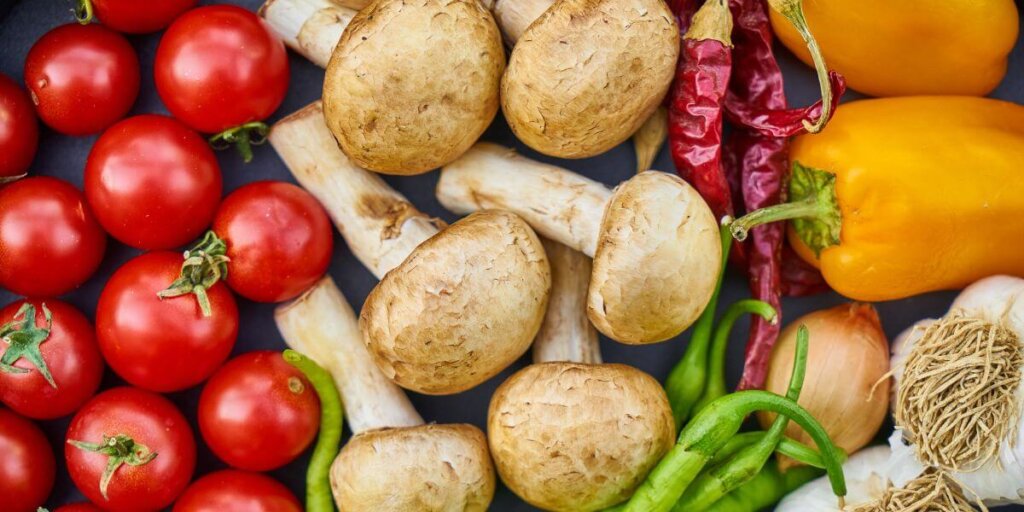Eating well doesn’t have to mean choking down bland salads or giving up your favorite comfort foods. Instead of obsessing over what to cut out, focus on what you can add. A sprinkle of chia seeds in your oatmeal, a handful of spinach in your smoothie, or swapping white rice for quinoa can instantly boost the nutrient content of your meals—without making you feel like you’re on a diet.
Quick look
- Instead of eliminating foods, boost nutrition by adding superfoods, protein, and healthy fats. Small swaps like chia seeds, spinach, or whole grains can make a big impact.
- Easy changes, such as using frozen veggies, swapping sugary drinks for sparkling water, and cooking with nutrient-packed herbs and spices, can effortlessly enhance your diet.
- Incorporate nutrient-dense options like sardines, liver, spirulina, and berries to maximize health benefits without overhauling your diet.
- Crash diets aren’t necessary. Look for long-term upgrades that improve energy, digestion, and overall well-being without sacrificing flavor or convenience.
10 ways to boost the nutrient content of your meals
Small, simple changes like these add up fast. Whether you sneak in superfoods, upgrade your morning coffee with a collagen supplement, or embrace the power of frozen veggies (yes, frozen is your friend!), eating healthier doesn’t have to be complicated. Let’s talk about easy, no-stress ways to make your meals work harder for you without sacrificing flavor or fun.
1. Start your day with protein
If your breakfast routine consists of a cup of coffee and a wish for more energy, it might be time for an upgrade. Protein is the MVP of morning meals—it keeps you full, supports muscle health, and helps you avoid that mid-morning crash that has you reaching for a donut (no judgment).
Adding protein doesn’t mean complicated meal prep. A scoop of protein powder in your smoothie, some Greek yogurt with berries, or a quick scrambled egg can set you up for a solid start. Even cottage cheese (seriously, give it a chance!) is packed with protein and pairs well with fruit, nuts, or even a drizzle of honey.
If you’re looking for protein on the go, try prepping some overnight oats with chia seeds and a spoonful of peanut butter, or grab a handful of almonds alongside your morning latte. Small changes, big benefits—your body (and energy levels) will thank you.
2. Sneak in superfoods
Superfoods might sound like something straight out of a superhero movie, but you don’t need a cape to use them. These tiny, nutrient-packed powerhouses can be slipped into your meals without extra effort.
Chia seeds and flaxseeds? Toss them into your oatmeal, yogurt, or even pancake batter to boost fiber, omega-3s, and protein. Spirulina? It might look like pond water, but it’s a legit nutritional goldmine—just blend a teaspoon into a smoothie and call it a day.
The best part? Superfoods don’t have to take over your plate. A sprinkle here, a scoop there, and suddenly, your usual breakfast, snack, or baked goods pack way more vitamins and minerals. Easy, effortless, and no weird diet rules required.
3. Flavor your foods with herbs and spices
If your meals taste a little meh, it’s time to raid your spice rack. Herbs and spices make your food taste better and they’re also packed with nutrients and health benefits, with no extra calories or sugar required.
Turmeric? It’s nature’s ibuprofen, thanks to its anti-inflammatory properties. Cinnamon? It helps regulate blood sugar and makes everything taste like dessert. Garlic? Aside from keeping vampires at bay, it’s a powerhouse for heart health.
And the best part? You don’t need to be a master chef to use them. A pinch of cinnamon in your coffee, some fresh basil in your pasta, or a shake of turmeric in your scrambled eggs can instantly upgrade your meal’s flavor and nutrition.
4. Swap sugary sodas for sparkling water
If your daily soda habit is less of a treat and more of a lifeline, don’t worry—you don’t have to go cold turkey. The key is swapping, not sacrificing. Sugary sodas may taste great, but they come with a side of blood sugar spikes and energy crashes. Reducing added sugar can improve metabolic health, support better digestion, and help you avoid that dreaded afternoon slump.
Enter sparkling water. It’s bubbly, refreshing, and way better for you. If plain fizz doesn’t do it for you, dress it up—add a squeeze of lemon or lime, toss in some fresh berries, or even drop in a few mint leaves for a fancy (yet ridiculously easy) upgrade.
And if you really miss soda, plenty of naturally flavored sparkling waters bring the fizz without the sugar. Your taste buds and energy levels will adjust faster than you think.
5. Don’t fear frozen
Frozen food gets a bad rap, but let’s clarify: your bag of frozen berries isn’t the same as a box of mystery meat nuggets from 2005. In fact, frozen fruits and veggies are often more nutrient-dense than fresh ones. They’re picked at peak ripeness and flash-frozen immediately, locking in all those vitamins and minerals. Meanwhile, that “fresh” produce at the store has likely been sitting in transit for days (or weeks), slowly losing nutrients.
The best part? Frozen fruits and veggies are budget-friendly, last longer, and make healthy eating more convenient. Need greens for a smoothie? Grab some frozen spinach. Want to add extra veggies to your stir-fry? A bag of frozen bell peppers is your new best friend—no washing, chopping, or racing against the clock before things go bad. Just ‘let it go’ with easy, nutrient-packed goodness straight from your freezer.
6. Use whole grains instead of refined grains
White bread and pasta might be comforting, but when it comes to nutrition, whole grains are where it’s at. Unlike refined grains, which have been stripped of most of their fiber and nutrients, whole grains keep all their good stuff—they help with digestion, keep you fuller longer, and support heart health.
Making the swap doesn’t mean giving up your favorite meals. If you love white rice, try brown rice, quinoa, or farro instead. Craving pasta? Whole wheat or chickpea pasta tastes just as good with your go-to sauce. Even your morning toast can get an upgrade—whole grain or sprouted bread brings more fiber and protein to the table without sacrificing flavor.
The best part is that whole grains digest more slowly, keeping your blood sugar steady and energy levels up. So, next time you’re reaching for the white rice, consider grabbing something heartier—you won’t miss the old stuff.
7. Add healthy fats to your meals
Fat got a bad reputation in the ‘90s, but it’s time to set the record straight—healthy fats are not the enemy. They’re essential for brain function, hormone health, and keeping your energy levels steady throughout the day. Plus, they make food taste amazing (because a dry salad is sad).
The easiest way to add more healthy fats? Drizzle olive oil over roasted veggies, toss some nuts into your oatmeal, or top your toast with mashed avocado. Seeds like flax, chia, and hemp also provide a solid dose of omega-3s, and fatty fish like salmon are another powerhouse for heart and brain health.
8. Incorporate more fiber
Fiber might be the missing piece if you’ve ever felt like you could eat a whole meal and still be hungry an hour later. This underrated nutrient is a game-changer—it keeps you full, supports digestion, and helps regulate blood sugar so you don’t crash and burn by mid-afternoon.
Luckily, getting more fiber doesn’t mean overhauling your diet. Start small: swap white bread for whole grain, throw black beans into your tacos, or add a handful of leafy greens to your scrambled eggs. Oats, lentils, chia seeds, and even popcorn (yes, really!) are also excellent sources of fiber that don’t require much effort.
Fiber-rich foods also naturally slow digestion, which means more stable energy levels and fewer surprise snack attacks. So go ahead—pile on the greens, mix in those beans, and let fiber do its thing.
9. Choose high-quality protein sources
Protein is essential for muscle repair, immune function, and keeping your energy levels steady throughout the day. However, not all protein sources are created equal. Choosing high-quality options ensures you’re getting the best nutrients without unnecessary additives.
Wild-caught fish, grass-fed beef, and free-range eggs provide more omega-3s, vitamins, and minerals than their conventional counterparts. If you’re plant-based, don’t worry—you’ve got plenty of protein options too! Lentils, chickpeas, quinoa, and tofu pack a serious protein punch while delivering fiber and essential nutrients.
Whether you add eggs to breakfast, salmon to dinner, or nuts and seeds to your snacks, prioritizing quality sources makes a difference in how you feel.
10. Hydrate smarter
Water is the ultimate MVP of nutrition, but if you’re only drinking it when you’re already thirsty, you’re playing catch-up. Hydration affects everything—energy, digestion, focus, and even your skin. And no, coffee alone doesn’t count (we wish).
Make it easy: keep a reusable water bottle on hand, sip throughout the day, and mix things up with herbal teas or infused water if plain H2O bores you. Electrolyte-rich drinks (without added sugar) can also help if you’re sweating or working long hours.
Proper hydration keeps your body running smoothly, so consider it the most straightforward nutrition upgrade you can make—no meal prep required.
Top nutrient-dense foods to add to your diet

If you want to get the most bang for your buck regarding nutrition, these powerhouse foods deliver serious health benefits without requiring complicated meal prep.
Sardines
Sardines are loaded with omega-3 fatty acids, which support brain and heart health, as well as calcium and vitamin D for strong bones. They’re also an excellent protein source with minimal contaminants compared to larger fish like tuna. Plus, they’re budget-friendly and come ready to eat—just pop open a can.
Liver
Liver and other organ meats might not be everyone’s first choice, but nutritionally, it’s a heavyweight champion. It’s packed with iron, vitamin A, B vitamins (especially B12), and choline, making it one of the most nutrient-dense foods on the planet. Iron is crucial for energy and oxygen transport, while B12 supports brain function.
Spirulina
This deep green algae might look intimidating, but it’s one of the most potent sources of plant-based protein (about 60-70% protein by weight) and loaded with antioxidants, iron, and B vitamins. Add it to smoothies or mix it into your morning juice for an instant nutrient boost.
Berries
Berries are packed with antioxidants like anthocyanins, which help protect your cells from damage, fight inflammation, and support brain health. They’re also high in fiber, which keeps digestion running smoothly and helps regulate blood sugar levels.
Avocado
Avocados are loaded with heart-healthy monounsaturated fats, potassium, and fiber. These nutrients support brain function and cardiovascular health and help keep you feeling full longer. Also, avocados contain more potassium than bananas, which is essential for maintaining healthy blood pressure.
Black beans
A go-to for plant-based eaters, black beans are rich in protein, fiber, iron, and magnesium. They help regulate blood sugar, support gut health, and provide sustained energy throughout the day. Plus, they’re incredibly versatile—toss them in salads, soups, or brownies for a sneak protein boost.
Seaweeds
Seaweed is one of the best natural sources of iodine, a mineral essential for healthy thyroid function and metabolism. It’s also packed with antioxidants, fiber, and omega-3s, making it a nutrient-dense addition to soups, sushi, or a crunchy snack.
Bottom line
Eating healthier doesn’t mean sacrificing your favorite foods or following complicated meal plans. Instead, think about what to add. A handful of nuts here, a scoop of chia seeds there, swapping white rice for quinoa—the little things add up to significant results.
Incorporating nutrient-dense ingredients into your daily meals will boost your energy, improve your focus, and support overall health without feeling deprived.
Want more easy nutrition tips, meal ideas, and health hacks? Subscribe to our newsletter for fresh insights delivered straight to your inbox!



